2006 HONDA ODYSSEY Indicator
[x] Cancel search: IndicatorPage 362 of 420
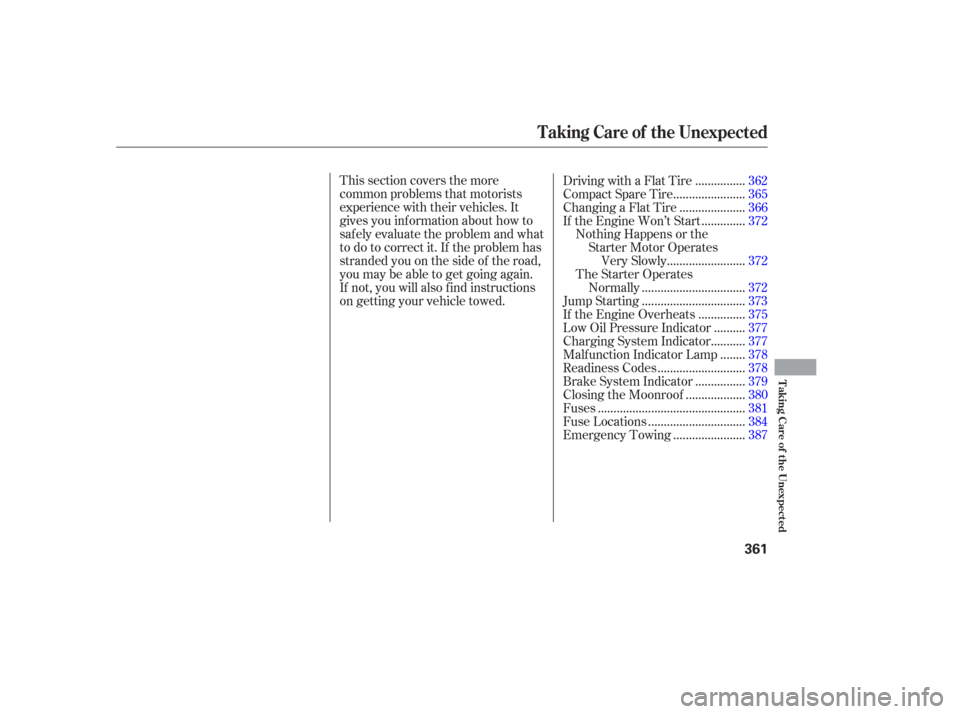
This section covers the more
common problems that motorists
experience with their vehicles. It
gives you inf ormation about how to
safely evaluate the problem and what
to do to correct it. If the problem has
stranded you on the side of the road,
you may be able to get going again.
If not, you will also f ind instructions
on getting your vehicle towed................
Driving with a Flat Tire .362
......................
Compact Spare Tire .365
....................
Changing a Flat Tire .366
.............
If the Engine Won’t Start .372
Nothing Happens or theStarter Motor Operates ........................
Very Slowly .372
The Starter Operates ................................
Normally .372
................................
Jump Starting .373
..............
If the Engine Overheats .375
.........
Low Oil Pressure Indicator .377
..........
Charging System Indicator .377
.......
Malf unction Indicator Lamp .378
...........................
Readiness Codes .378
...............
Brake System Indicator .379
..................
Closing the Moonroof .380
..............................................
Fuses .381
..............................
Fuse Locations .384
......................
Emergency Towing .387
Taking Care of the Unexpected
T aking Care of t he Unexpect ed
361
Page 363 of 420
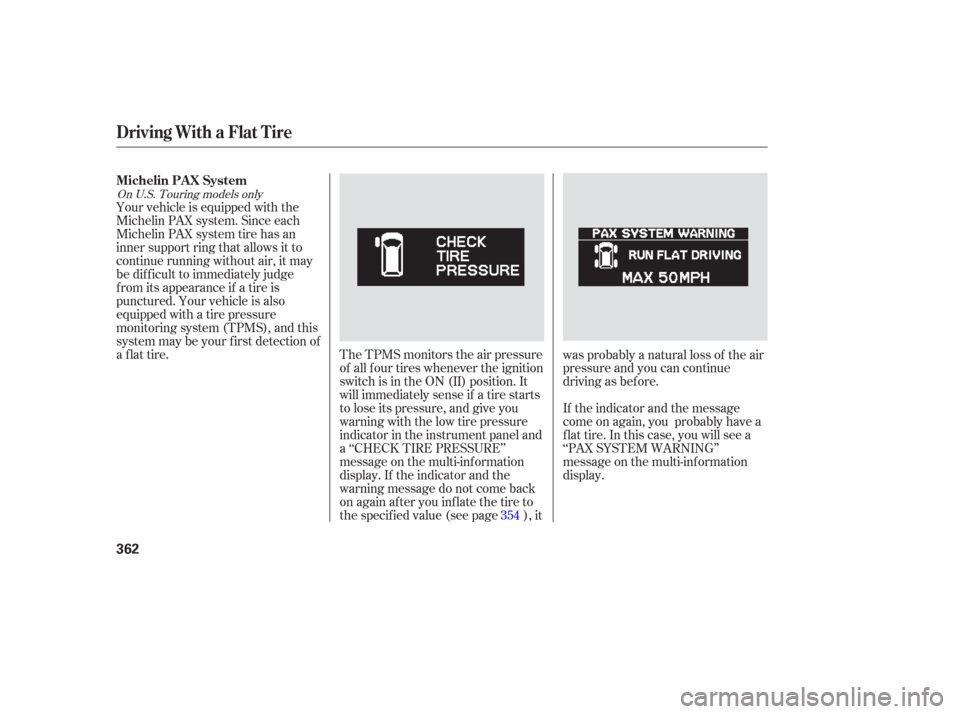
Your vehicle is equipped with the
Michelin PAX system. Since each
Michelin PAX system tire has an
inner support ring that allows it to
continue running without air, it may
be dif f icult to immediately judge
f rom its appearance if a tire is
punctured. Your vehicle is also
equipped with a tire pressure
monitoring system (TPMS), and this
system may be your f irst detection of
a f lat tire.The TPMS monitors the air pressure
of all f our tires whenever the ignition
switch is in the ON (II) position. It
will immediately sense if a tire starts
to lose its pressure, and give you
warning with the low tire pressure
indicator in the instrument panel and
a ‘‘CHECK TIRE PRESSURE’’
message on the multi-inf ormation
display. If the indicator and the
warning message do not come back
on again af ter you inf late the tire to
the specif ied value (see page ), it was probably a natural loss of the air
pressure and you can continue
driving as bef ore.
If the indicator and the message
come on again, you probably have a
flat tire. In this case, you will see a
‘‘PAX SYSTEM WARNING’’
message on the multi-information
display.
354
On U.S. Touring models only
Driving With a Flat Tire
Michelin PA X System
362
Page 366 of 420

Replace the tire when you can see
the tread wear indicator bars. The
replacement should be the same size
and design tire, mounted on the
same wheel. The spare tire is not
designed to be mounted on a regular
wheel, and the spare wheel is not
designed f or mounting a regular tire.
Do not mount snow chains on the
compact spare tire.
Turn of f the VSA system (see
pages and ). Driving with
thecompactsparetiremay
activate the VSA. Do not use your compact spare
tire on another vehicle unless it is
thesamemakeandmodel. Do not use the compact spare tire
if you are towing a trailer.
This tire gives a harsher ride and
less traction on some road sur-
f aces. Use greater caution while
driving. Never exceed 50 mph (80 km/h)
under any circumstances.
Follow these precautions: Check the inf lation pressure of the
compact spare tire every time you
check the other tires. It should be
inf lated to: Use the compact spare tire as a
temporary replacement only. Get
your regular tire repaired or replaced,
and put it back on your vehicle as
soon as you can.
307 308
All models except U.S. Touring
Compact Spare T ire
T aking Care of t he Unexpect ed
365
INDICATOR LOCATION MARK
TREAD WEAR INDICATOR BAR
60 psi (420 kPa , 4.2 kgf/cm)
Page 374 of 420
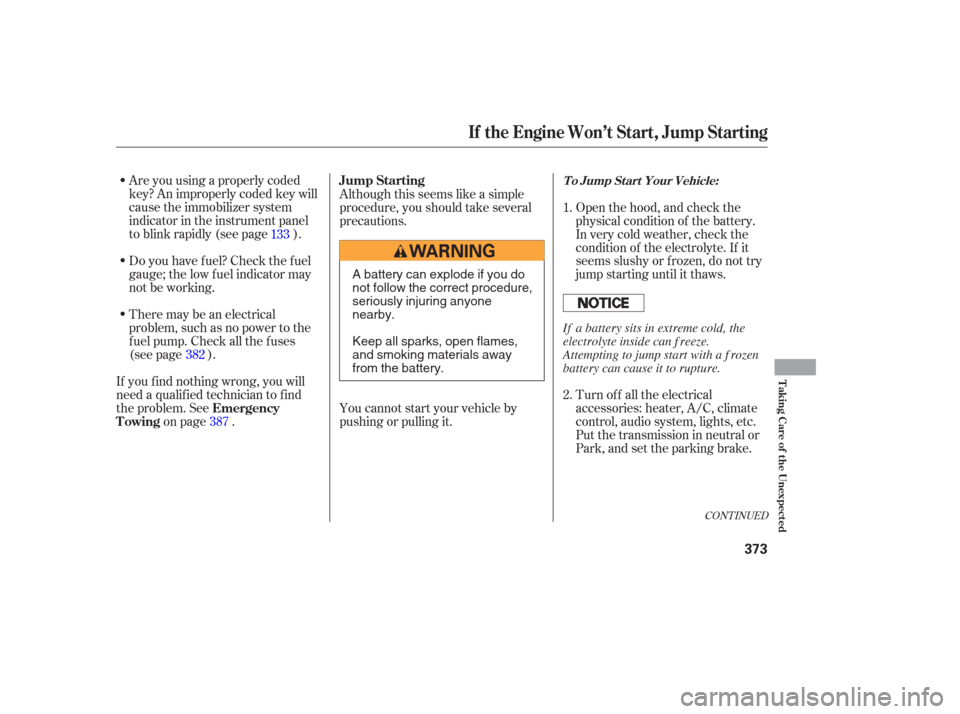
Are you using a properly coded
key? An improperly coded key will
cause the immobilizer system
indicator in the instrument panel
to blink rapidly (see page ).
Do you have f uel? Check the f uel
gauge; the low f uel indicator may
not be working.
There may be an electrical
problem, such as no power to the
f uel pump. Check all the f uses
(see page ).
If youfindnothingwrong,youwill
need a qualif ied technician to f ind
the problem. See on page . Although this seems like a simple
procedure, you should take several
precautions.
Open the hood, and check the
physical condition of the battery.
In very cold weather, check the
condition of the electrolyte. If it
seems slushy or f rozen, do not try
jump starting until it thaws.
You cannot start your vehicle by
pushing or pulling it. Turn of f all the electrical
accessories: heater, A/C, climate
control, audio system, lights, etc.
Put the transmission in neutral or
Park, and set the parking brake.
1.
2.
133
382 387
CONT INUED
Emergency
Towing Jump Starting
To Jump Start Your Vehicle:
If the Engine Won’t Start, Jump Starting
T aking Care of t he Unexpect ed
373
A battery can explode if you do
not follow the correct procedure,
seriously injuring anyone
nearby.
Keep all sparks, open flames,
and smoking materials away
from the battery.
If a battery sits in extreme cold, the
electrolyte inside can f reeze.
Attempting to jump start with a f rozen
battery can cause it to rupture.
Page 376 of 420
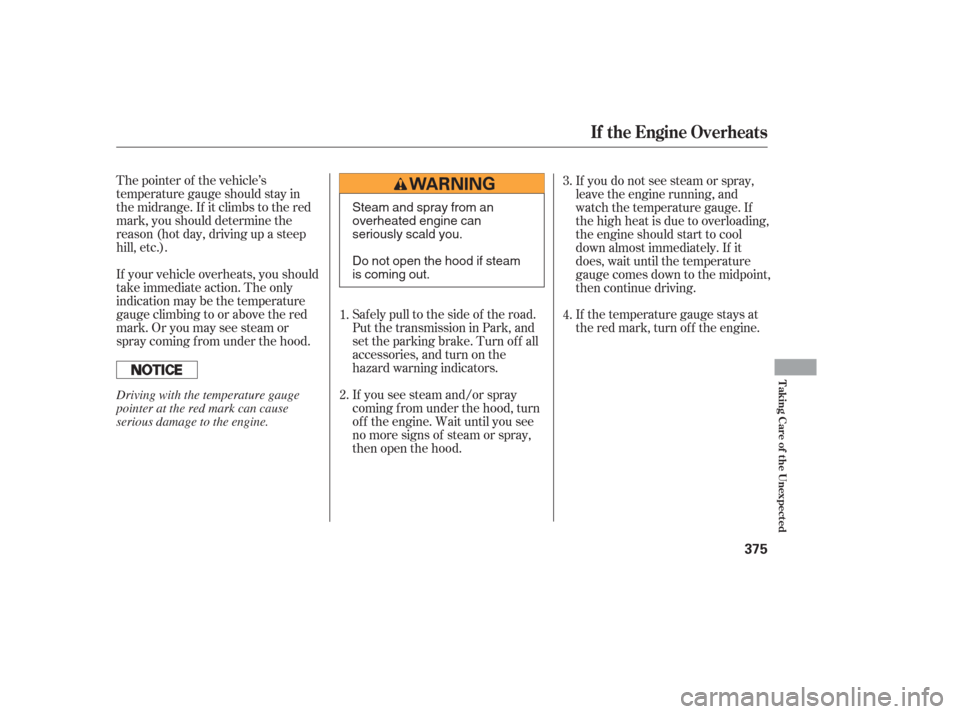
The pointer of the vehicle’s
temperature gauge should stay in
the midrange. If it climbs to the red
mark, you should determine the
reason (hot day, driving up a steep
hill, etc.).
If your vehicle overheats, you should
take immediate action. The only
indication may be the temperature
gauge climbing to or above the red
mark. Or you may see steam or
spray coming f rom under the hood.If you see steam and/or spray
coming f rom under the hood, turn
of f the engine. Wait until you see
no more signs of steam or spray,
then open the hood.If you do not see steam or spray,
leave the engine running, and
watch the temperature gauge. If
the high heat is due to overloading,
the engine should start to cool
down almost immediately. If it
does, wait until the temperature
gauge comes down to the midpoint,
then continue driving.
If the temperature gauge stays at
the red mark, turn off the engine.
Saf ely pull to the side of the road.
Put the transmission in Park, and
set the parking brake. Turn of f all
accessories, and turn on the
hazard warning indicators.
1.
2. 3.
4.
If theEngineOverheats
T aking Care of t he Unexpect ed
375
Steam and spray from an
overheated engine can
seriously scald you.
Do not open the hood if steam
is coming out.
Driving with the temperature gauge
pointer at the red mark can cause
serious damage to the engine.
Page 378 of 420
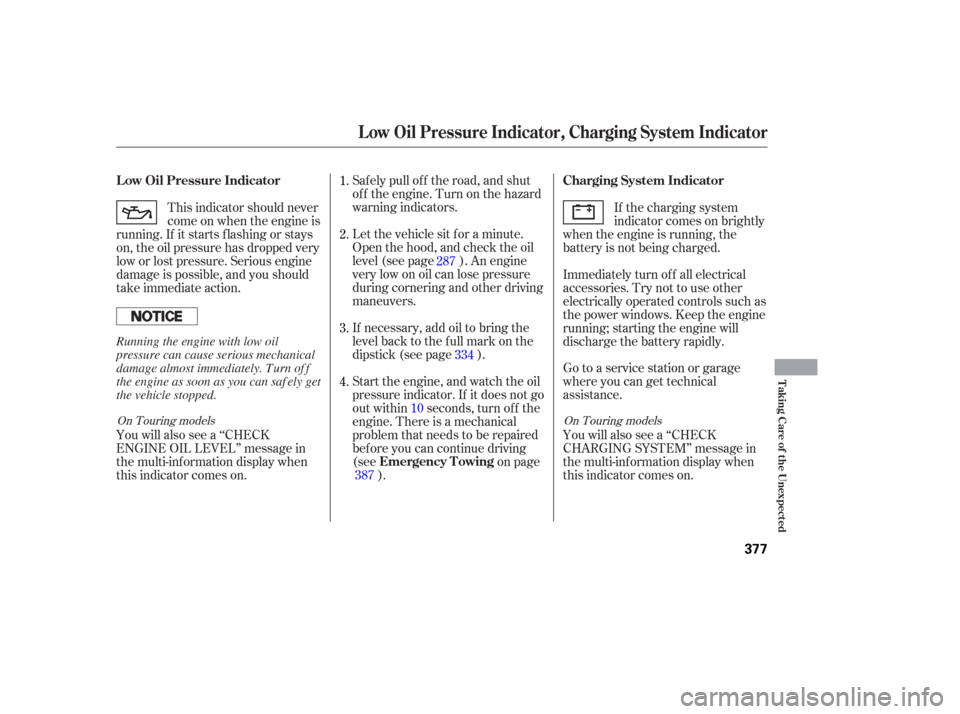
Saf ely pull of f the road, and shut
of f the engine. Turn on the hazard
warning indicators.
Let the vehicle sit f or a minute.
Open the hood, and check the oil
level (see page ). An engine
very low on oil can lose pressure
during cornering and other driving
maneuvers.
If necessary, add oil to bring the
level back to the full mark on the
dipstick (see page ).
Start the engine, and watch the oil
pressure indicator. If it does not go
out within10seconds, turn of f the
engine. There is a mechanical
problem that needs to be repaired
bef ore you can continue driving
(see on page
).
You will also see a ‘‘CHECK
ENGINE OIL LEVEL’’ message in
the multi-information display when
this indicator comes on. This indicator should never
come on when the engine is
running. If it starts f lashing or stays
on, the oil pressure has dropped very
low or lost pressure. Serious engine
damage is possible, and you should
take immediate action.
You will also see a ‘‘CHECK
CHARGING SYSTEM’’ message in
the multi-information display when
this indicator comes on. Go to a service station or garage
where you can get technical
assistance. Immediately turn of f all electrical
accessories. Try not to use other
electrically operated controls such as
the power windows. Keep the engine
running; starting the engine will
discharge the battery rapidly.If the charging system
indicator comes on brightly
when the engine is running, the
battery is not being charged.
1.
2.
3.
4. 287
334
387
On Touring models On Touring models
L ow Oil Pressure Indicator
Emergency T owingCharging System Indicator
L ow Oil Pressure Indicator, Charging System Indicator
T aking Care of t he Unexpect ed
377
Running the engine with low oil
pressure can cause serious mechanical
damage almost immediately. Turn of f
the engine as soon as you can saf ely get
the vehicle stopped.
Page 379 of 420
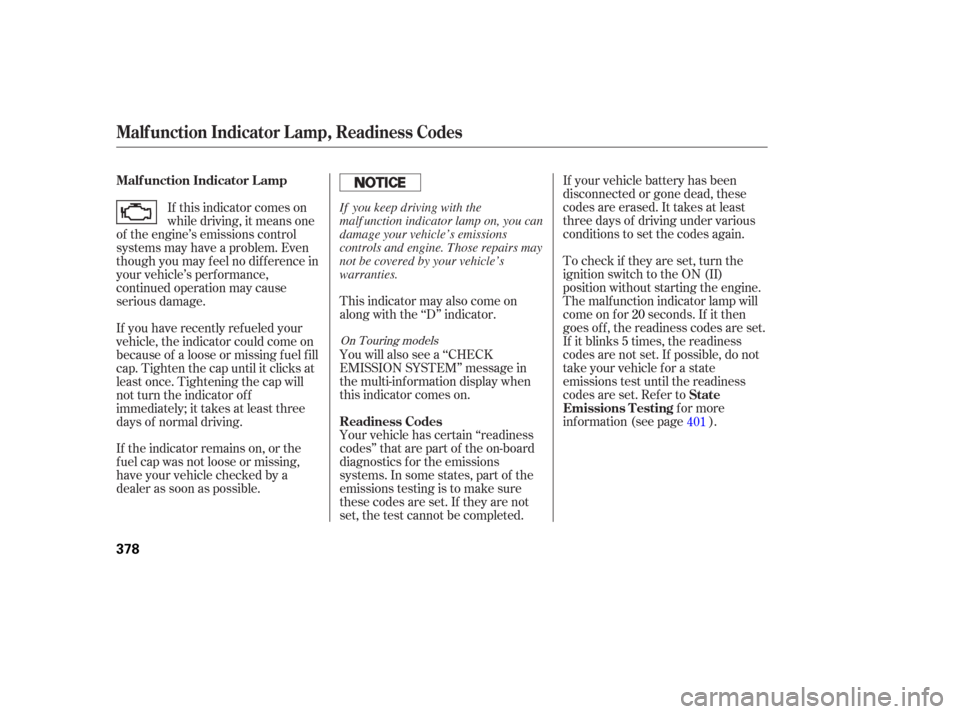
This indicator may also come on
along with the ‘‘D’’ indicator.If your vehicle battery has been
disconnected or gone dead, these
codes are erased. It takes at least
three days of driving under various
conditions to set the codes again.
You will also see a ‘‘CHECK
EMISSION SYSTEM’’ message in
the multi-information display when
this indicator comes on.
Your vehicle has certain ‘‘readiness
codes’’ that are part of the on-board
diagnostics f or the emissions
systems. In some states, part of the
emissions testing is to make sure
these codes are set. If they are not
set, the test cannot be completed. To check if they are set, turn the
ignition switch to the ON (II)
position without starting the engine.
The malf unction indicator lamp will
come on f or
20seconds. If it then
goes of f , the readiness codes are set.
If it blinks 5times, the readiness
codes are not set. If possible, do not
take your vehicle for a state
emissions test until the readiness
codes are set. Ref er to for more
inf ormation (see page ).
If the indicator remains on, or the
f uel cap was not loose or missing,
have your vehicle checked by a
dealer as soon as possible. If this indicator comes on
while driving, it means one
of the engine’s emissions control
systems may have a problem. Even
though you may f eel no dif f erence in
your vehicle’s perf ormance,
continued operation may cause
serious damage.
If you have recently ref ueled your
vehicle, the indicator could come on
because of a loose or missing f uel f ill
cap. Tighten the cap until it clicks at
least once. Tightening the cap will
not turn the indicator of f
immediately; it takes at least three
days of normal driving. 401
On Touring models
Readiness Codes
Malf unction Indicator L amp
State
Emissions T esting
Malf unction Indicator L amp, Readiness Codes
378
If you keep driving with the
malf unction indicator lamp on, you can
damage your vehicle’s emissions
controls and engine. Those repairs may
not be covered by your vehicle’s
warranties.
Page 380 of 420
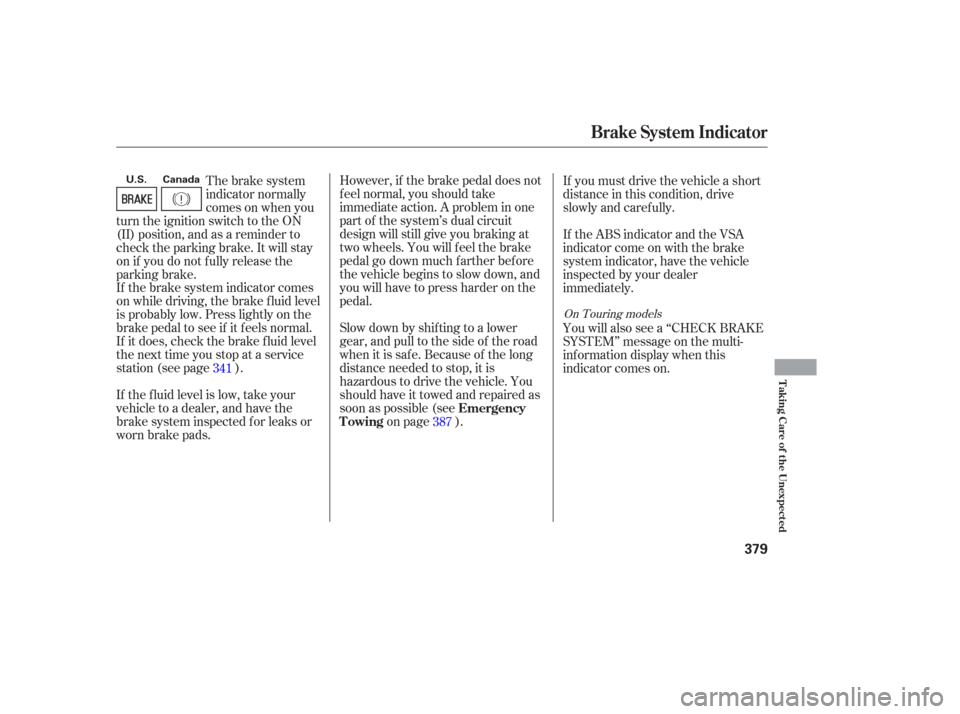
However, if the brake pedal does not
f eel normal, you should take
immediate action. A problem in one
part of the system’s dual circuit
design will still give you braking at
two wheels. You will f eel the brake
pedal go down much f arther bef ore
the vehicle begins to slow down, and
you will have to press harder on the
pedal.
Slow down by shif ting to a lower
gear, and pull to the side of the road
when it is saf e. Because of the long
distance needed to stop, it is
hazardous to drive the vehicle. You
should have it towed and repaired as
soon as possible (seeon page ). If you must drive the vehicle a short
distance in this condition, drive
slowly and caref ully.
If the brake system indicator comes
on while driving, the brake f luid level
is probably low. Press lightly on the
brake pedal to see if it f eels normal.
If it does, check the brake f luid level
thenexttimeyoustopataservice
station (see page ).
If the f luid level is low, take your
vehicle to a dealer, and have the
brake system inspected f or leaks or
worn brake pads. The brake system
indicator normally
comesonwhenyou
turn the ignition switch to the ON
(II) position, and as a reminder to
check the parking brake. It will stay
on if you do not f ully release the
parking brake. If the ABS indicator and the VSA
indicator come on with the brake
system indicator, have the vehicle
inspected by your dealer
immediately.
You will also see a ‘‘CHECK BRAKE
SYSTEM’’ message on the multi-
inf ormation display when this
indicator comes on.
387
341
On Touring models
Emergency
Towing
Brake System Indicator
T aking Care of t he Unexpect ed
379
U.S. Canada